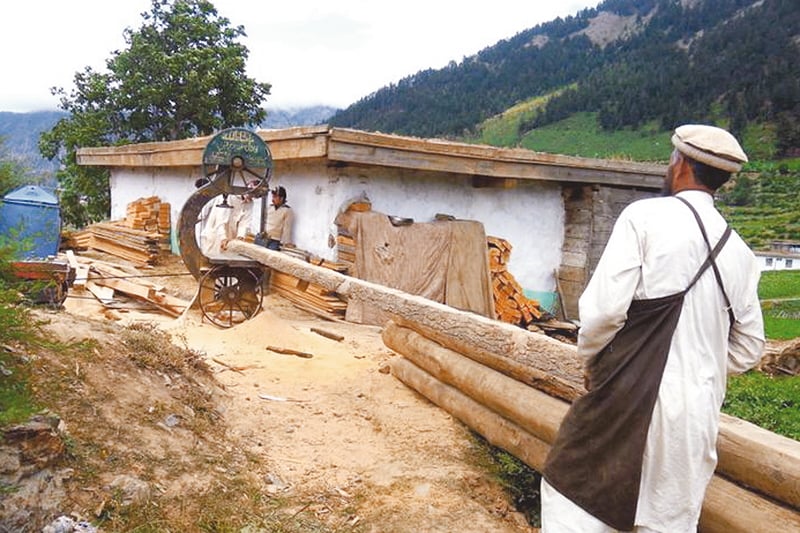
Swat Valley has become a shadow of its former self. Faced with massive deforestation, it is gradually losing its grandeur and idyllic beauty.
Once upon a time, the valley was billed as ‘Paradise on Earth’ and ‘The Switzerland of Asia’. It was a treasure trove of fascinating landscapes, sprawling meadows, azure lakes and fruit orchards. In many respects, the valley was little more than a holiday destination. Thousands of tourists would visit Swat Valley to relish its sights and sounds and become one with nature. In its towering mountains and spellbinding beauty, they would find momentary reprieve from the cares of the world.

However, the story of its rapid deterioration is now written in every nook and cranny of the valley. What remains are forests, wetlands, wildlife and breeding spaces which are in danger of becoming extinct.
Valley of doom
Home is where the heart is. But when the home you inhabit changes suddenly and drastically, the outcome is far from promising. The animals which inhabit Swat Valley are faced with a similar dilemma. Rising temperatures triggered by climate change have negatively impacted their habitat.
The lush, dense forests which were once the secret of the valley’s beauty have gradually lost ground. As a result, nesting and breeding grounds of most animals have been disturbed.
It requires little soul-searching to realise that these drastic changes taking place before our very own eyes are inherently man-made. Our ignorance and recklessness has completely defaced the beauty of the valley. Furthermore, outdated legislation on deforestation and illegal hunting has been repeatedly impinged upon.

As most of the forests in the area have become victims of the woodcutter’s axe, what remains are barren hills and mountains. Low-lying areas which can be accessed through mountain tracks have been mostly affected by the deforestation. Darra Parona and Jambil Kokarai, which were once covered with forests, now appear barren and nondescript. Most of the trees have been chopped and it seems as if no forest ever existed there at all. What is more, a large number of forests were cut when the road connecting Swat and Buner districts at Kalil Kandaw was constructed.
Similarly, Khwazakhela and its suburbs were also laden with forests. However, smugglers began stealing timber from the bordering areas along Shangla district and Swat, leaving the woods bare and empty.
Unfortunately, a large number of forests in the area have encountered a similar fate. The Asharbanr forest in Kanju and the others forests in Odigram and Fizagat are now barren. Even scenic spots such as Kalam, Malam Jaba and Miandam are under threat.
The wasteland
Deforestation isn’t the only problem which plagues the region. Over the years, Swat Valley has turned into a wasteland as a result of eco-unfriendly practices. Pollution in the valley has added a heavy layer of grime on the otherwise green landscape. Furthermore, pollutants have been released into the atmosphere, poisoning the soil, waterways and highland pastures. The water from streams, springs and the Swat River is full of toxic chemicals. It has been contaminated with runoff from nearby farms and waste from landfills or the streets.

Precious forests are thinning out because of the timber mafia. PHOTOS: MIANGUL ABDULLAH
In some cases, people have dumped waste into the river and streams without realising its implications on the quality of water. They fail to see the debris accumulates in the water in large patches and triggers environmental degradation. Consequently, a majority of streams and springs have either dried up or become contaminated.
Timber mafia
The threat of environmental degradation was never this acute. Under British colonial rule, when Swat was a princely state, the situation was comparatively better. Forests were adequately protected because all the major institutions worked in unison to maintain them. Severe punishments were meted out to those who violated laws. As such no one dared to fell even a single shoot of a tree during the British Raj.
But alas, this form of deterrence has become a thing of the past. In this day and age, the forest department has failed to implement a similar system of checks and balances. Over the years, a mafia which smuggles timber to different parts of the country has emerged and is mercilessly cutting down Swat’s forests. It is widely assumed that the group is being backed by the forestry department. However, these allegations have not been proved to date.

Wood piled up in a forest in Swat Valley. PHOTOS: MIANGUL ABDULLAH
There are also other causes for the gradual depletion of timber in Swat Valley. For instance, the prevalence of gas loadshedding in the region and the absence of gas facilities beyond Mingora and its suburbs has forced people to use timber from forests to cook. Even then it is assumed the timber mafia is largely responsible for deforestation in the area.
Trespassing on nature
Professional woodcutters have developed new and innovative techniques to shift timber to the roads. They have built bridges, over which timber is flung directly onto roads from the mountains.
In addition, a large number of sites which bear cultural significance have been neglected and, in many cases, destroyed. There is a lack of interest in preserving these places as they do not have much importance as tourist sites.
The gradual deterioration of the valley serves as a reminder of how trespassing on nature can impact the lives of people and animals. Natural resources are in jeopardy. The activities of the timber mafia have destroyed the natural habitat and ecosystems have not adapted to the changing environment. At this critical juncture, conservation poses a major challenge.
Cause and effect
Every one of us talks about preserving nature and its precious resources. Environmental organisations hold costly seminars at expensive hotels and make tall claims about protecting forests and natural resources. However, the outcome has been far from favourable.

Tree stumps at a forest in Swat Valley. PHOTOS: MIANGUL ABDULLAH
According to an officer of the divisional forest office, the current policy framework has stunted any progress in this regard.
“There are loopholes in policies,” he says. “Favouritism is a common practice in allocating and distributing quotas for cutting trees. There are quite a few irregularities in the forestry sector which need attention.”
The official claims every government which has come into power has failed to implement positive steps to protect forests.
“There is a difference between making promises and taking action,” he says. “More often than not, the ruling party fails to achieve the targets it has set for itself.”
According to the official, the previous Awami National Party (ANP) government approved major projects such as carbon sequestration for replenishment and also planned to increase forest cover. It had allocated Rs360 million from the Annual Development Programme (ADP) for the forestry sector and also introduced several policy guidelines for better management and development of natural resources. These measures included integrated resource management and participation of local communities in planning and monitoring natural resource management (NRM) activities.
However, the erstwhile government’s efforts did not bear fruit. Although funds were allocated to conserve forests, widespread losses to biodiversity continued unabated.
“Making policies is not the solution to our plight,” he says. “We need proper implementation to stave off this crisis. If we fail to do this, billions of rupees which we spend every year on development schemes will go to waste”.
The current Pakistan Tehreek-e-Insaf (PTI) government has its eyes on a much-hyped ‘tsunami’ plantation campaign, the official added. Citing a booklet issued by the government, he said the five-year project is aimed at enhancing the forest cover of the province from 20% to 25% through enrichment planting and promotion of regeneration in natural forests. Moreover, it is geared towards strengthening Disaster Risk Reduction (DRR) with integrated watershed management. The new scheme also seeks to improve forest-based livelihood through improved non-timber forest produce (NTFP) management, ecotourism promotion and enterprise orientation, he added.

Timber being transported from forests to industries. PHOTOS: MIANGUL ABDULLAH
Under the new scheme, PTI volunteers will plant 15 million trees. The official insists that the PTI government should renew its commitment to the cause.
“There is a pressing need for collective efforts by all stakeholders to host, reverse and improve the condition of forests in Swat Valley,” he says. “They must use print and digital media effectively to raise awareness about this scheme.”
Muhammad Riaz, the divisional forest officer of Swat Forest Division, explains that a series of projects are in the works to improve the situation.
“These projects include building nurseries, afforestation, direct sowing, soil conservation, kitchen gardening and distribution of seeds among farmers,” Riaz says.
However, these targets will be difficult to achieve without active participation by the local community, he adds.
“We hope thorough monitoring and evaluation will help us achieve positive results,” the officer says. According to Riaz, programmes are being conducted to raise awareness among local communities.
The other view
Natural healing is always the most effective solution to any problem. Khirad Muhammad, a government contractor in Lalko village, is a strong proponent of this view. He claims that the cutting of wood does not have an adverse impact. On the contrary, it could, in all likelihood, have a positive effect and allow nature to take its course.
“Harvesting is essential for fresh and healthy growth,” he explains. “Regular marking of dry wood and windfall controls the risk of damage caused by flooding.”
However, he admits that not everything can be left to nature. Human effort is still required in maintaining the ecological balance. According to Muhammad, the government has not adopted a proactive approach in marking areas and ensuring equal distribution of wood among locals.
“Wood should be equally distributed among locals at concessional rates by setting up local depots,” Muhammad says.
Long live the jungle
Muhammad believes cattle have caused immense damage to Swat’s forests and insists that suitable grazing points should be identified to prevent any risk to plant life.
“These grazing points should also be changed from time to time,” he says. “This should ideally happen between February and June – which is the peak time for breeding.”
Muhammad believes this practice will reduce the need for afforestation due to strong natural growth. “This saves millions of rupees spent on procuring plants,” he adds.
According to a community development officer (CDO), Faisal Shehzad, the neglected forestry sector can be only salvaged through action rather than rhetoric. Superficial attempts to address structural problems within the department are unlikely to have the desired effect.
“The government should develop a monitoring and evaluation system to achieve its objectives,” Shehzad says. “It should not confine itself to internal monitoring only as department officials could try to hamper the process.”
Shehzad advocates the need for third-party monitoring bodies.
“Volunteers are needed to provide oversight in decision-making,” he explains. “They can ensure that the monitoring function is conducted in a neutral manner.”
More significantly, the process should also include a geographic information system (GIS). According to Shehzad, this is a geo-spatial analysis tool, which, if implemented in the forestry department for roughly five to 10 years, could streamline planning and monitoring.
Published in The Express Tribune, February 11th, 2015.
Like Life & Style on Facebook, follow @ETLifeandStyle on Twitter for the latest in fashion, gossip and entertainment.
1731583017-0/diddy-(42)1731583017-0-405x300.webp)


1719315628-0/BeFunky-collage-(8)1719315628-0-165x106.webp)


1731829111-0/Copy-of-Untitled-(8)1731829111-0-270x192.webp)



1731825692-0/Express-Tribune-(1)1731825692-0-270x192.webp)






COMMENTS (2)
Comments are moderated and generally will be posted if they are on-topic and not abusive.
For more information, please see our Comments FAQ